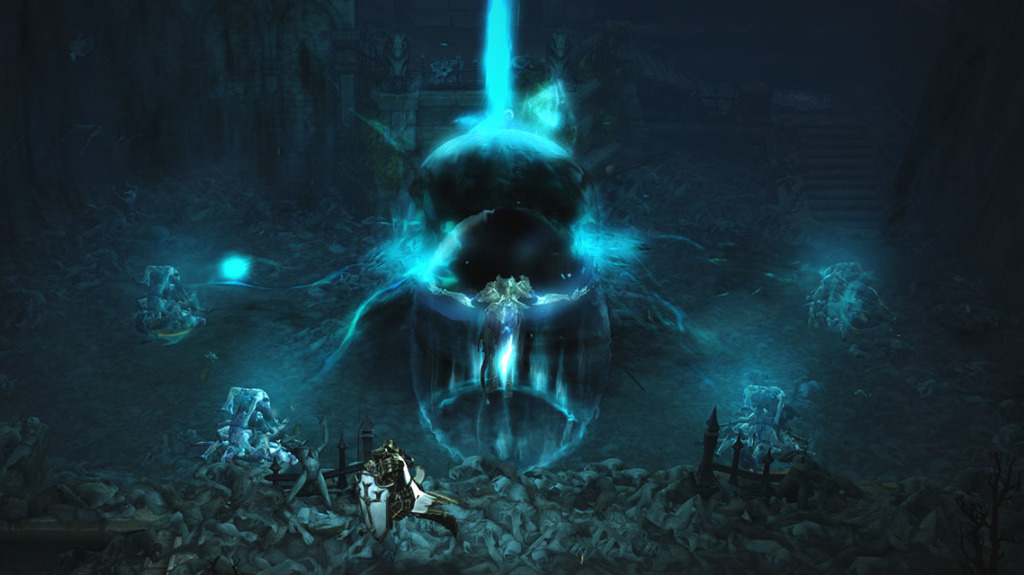Take pains with these things; be absorbed in them, so that your progress will be evident to all. Pay close attention to yourself and to your teaching; persevere in these things, for as you do this you will ensure salvation both for yourself and for those who hear you.
1 Timothy 4:15-16
Finally, we make our way to the current, final iteration of Diablo III (for the moment). Although Reaper of Souls as an expansion takes a relatively conservative and light stance on “new” content (I mean, seriously, one new character class?), especially for its retail price, it more than makes up for it and refines the product to what I imagine they intended in the first place. And man, did they ever bother to absorb themselves in Diablo’s great ideas, bringing them to the forefront while getting rid of much of the things that made me hate its earlier incarnations.
Thankfully, Blizzard finally decided to remove both the Real Money Auction House and the foolish loot model which birthed such hatred towards it. Loot 2.0, s0-called, was born, and it instantly made Diablo III a better game upon its patch. But the expansion, titled “Reaper of Souls”, did its own part to finally make Diablo III a great game, rather than an awful one. Since the core satisfying action remain, Reaper of Souls simply posits a few changes that transform a game of iterative design tweaks into something wonderfully holistic.
First, you actually control the drop rate of loot and items through a revised difficulty system. Originally, you chose a Mode and then a Difficulty level; now, a new system of varying challenge and reward over a series of ten choices make things easy. For the most part, you can scale the game to your personal preferences, with higher mode like Torment’s six variations offering the greater rewards. Master and Torment difficulties only unlock after completion of Act IV, but I consider this a minor setback which treats the main game as an extended tutorial – not unwarranted, given that the campaign exists as a starting point for Diablo at best. Being able to scale the difficulty actually creates a real difficulty curve from the beginning of the game to the end. For me, I bounced from Hard to Expert to Master, and each jump felt like a significant challenge.
The new Act V, because of this, is incredibly well-done, if somewhat short, and while the plot still does nothing interesting it makes for some interesting enemy designs and locales. New bosses also turn into tense combat rounds, as the ever present “don’t stand in things on the ground” becomes even more important. Enemies do tons of damage now, and you might need skill to survive (at least on Master and above, at least). Malthael provided quite a challenge, and I actually DIED to normal enemy mobs in the last few areas – of course, I refuse to back down from a fair challenge, so I continued onward with a new weapon instead.
Because of Loot 2.0, most any challenge can be solved with better gear or smarter gear choices, and that came into play often in my playthrough. The frequency of legendaries and rares got bumped up by a huge margin, with each difficulty providing a bigger bonus to excellent drop rates. Every big major boss drops one at the very least, and sometimes you end up with tons of surprises in the normal game. I gotta say, the possible incentive of getting a huge upgrade that, based on stats, could change how you play the game often keeps things exciting.
The new statistics distribution also forces some hard choices on you. The original iterations really revolved around exactly two stats – weapon damage and your primary stat. If a weapon had a higher attack stat, equip it and win; if it had your desired stat (Strength for Barbarian/Crusader, Dexterity for Demon Hunter/Monk, Intelligence for Wizard/Witch Doctor), even better. At the same time, stack enough Vitality to live through monster mobs and you were good to go. Much of this basic framework remains, but Loot 2.0 wants you to choose wisely. Augmentations of elemental damage make Skill Rune choice quite important, and percentage-based augmentations to core abilities mean you’ll need to decide which stats you want. Since those percentages don’t get factored into the game’s quickloot system (which uses green and red arrows to tell you whether something’s an upgrade), you need to make some decisions for yourself based on your desired build. You can tailor yourself to your gear, but how big of an upgrade is it? Finally, there’s some though that goes into this loot system.
Primarily, you want to gear for efficiency – how do I kill the greatest number of enemies in the shortest amount of time? Gear plays into this, since your augmented abilities will do loads more damage than a weapon attack ever will do. My Crusader’s augmented Blessed Hammers, for example, can completely wreck an enemy group when I pop the right abilities at the same time, and since 13% buffs to the ability stack, it gets super crazy. The game even encourages this by giving experience bonuses when you kill large numbers of enemies at a time. Massacres, as the game calls them, continue as long as you actively hit a hostile target, meaning you could chain a Massacre and received a multiplicative bonus on all enemies in said Massacre. Destroying more than seven objects gets you a speed boost you can implement in said Massacres. Really, these sorts of little games would mean nothing in lesser games, but they give you an incentive to play in efficient ways.

